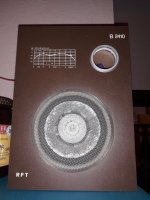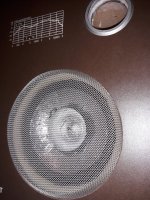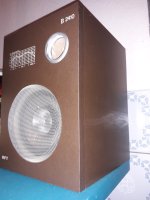How does it sound? Part II
I am used to use DSP to correct for frequency irregularities of my fullrange loudspeaker projects.
This was MiniDsp and Behringer DEQ2496 - this was done assisted by measurements and final fine tuning by comparison of the loudspeakers against real instruments I recorded with very good recording equipment outside in the free field and in the near field of the instruments i.e. 50cm distance. (in order to get a "dry recording")
I am so pleased to hear fullrange drivers sounding very convincing in small boxes:
Current drive does nearly all the job correcting the loudspeakers in the high frequencies and in the bass.
Current drive seems to make them play lower than expected and this without sophisticated DSP work.
Somehow its a combination of better frequency response, better impulse reproduction and distortion reduction.
Example for a simple fullrange driver is the 13cm driver Eagle L033B for 16 Euro. It got aluminium from both sides to convert it to a sandwich cone. It has no faraday ring.
It sounded with a standard voltage amplifier and no crossover in a small box bass shy and on the amplifier it worked only with extra bass and highs from the preamp and activated loudness. The sound was undefined in the bass and the mids full of distortion (I know the difference in sound from fullrange drivers with copper rings - I also know how to add a copper ring on the top of a pole piece and know how a driver sound after this modification - tested with A/B comparison with the balance knob on the preamp). The highs sounded a bit artificial.
With current drive everything changes. The mids are clean without distortion but also all the way down to the bass now sounds balanced and somehow deeper - just more quality. The preamp works then without bass and high frequency attenuation!
For me its like a magic trick and makes standard drivers sound classy. An amplifier which helps the driver sound good.

Eagle L022B Mk2 15,60 EUR
weich, 10cm Magnet, 92dB/W, fs:63.4Hz, Qts:0.64, Vas:6.49l, 45/60 W/8 Ohm, 970g, Durchmesser 131mm/113mm, Hochtonkegel, glänzend beschichtet (jetzt gleiche Membran wie 16cm L026B), 25mm-Schwingspule, 63-20000 Hz
Modified Tda 2004 to current drive
https://www.diyaudio.com/community/...fication-to-current-drive.389985/post-7374665
I am used to use DSP to correct for frequency irregularities of my fullrange loudspeaker projects.
This was MiniDsp and Behringer DEQ2496 - this was done assisted by measurements and final fine tuning by comparison of the loudspeakers against real instruments I recorded with very good recording equipment outside in the free field and in the near field of the instruments i.e. 50cm distance. (in order to get a "dry recording")
I am so pleased to hear fullrange drivers sounding very convincing in small boxes:
Current drive does nearly all the job correcting the loudspeakers in the high frequencies and in the bass.
Current drive seems to make them play lower than expected and this without sophisticated DSP work.
Somehow its a combination of better frequency response, better impulse reproduction and distortion reduction.
Example for a simple fullrange driver is the 13cm driver Eagle L033B for 16 Euro. It got aluminium from both sides to convert it to a sandwich cone. It has no faraday ring.
It sounded with a standard voltage amplifier and no crossover in a small box bass shy and on the amplifier it worked only with extra bass and highs from the preamp and activated loudness. The sound was undefined in the bass and the mids full of distortion (I know the difference in sound from fullrange drivers with copper rings - I also know how to add a copper ring on the top of a pole piece and know how a driver sound after this modification - tested with A/B comparison with the balance knob on the preamp). The highs sounded a bit artificial.
With current drive everything changes. The mids are clean without distortion but also all the way down to the bass now sounds balanced and somehow deeper - just more quality. The preamp works then without bass and high frequency attenuation!
For me its like a magic trick and makes standard drivers sound classy. An amplifier which helps the driver sound good.
Eagle L022B Mk2 15,60 EUR
weich, 10cm Magnet, 92dB/W, fs:63.4Hz, Qts:0.64, Vas:6.49l, 45/60 W/8 Ohm, 970g, Durchmesser 131mm/113mm, Hochtonkegel, glänzend beschichtet (jetzt gleiche Membran wie 16cm L026B), 25mm-Schwingspule, 63-20000 Hz
Modified Tda 2004 to current drive
https://www.diyaudio.com/community/...fication-to-current-drive.389985/post-7374665
Attachments
Last edited:
No?With Ohm's law you can work out that 22 ohm added to a nominal 8 ohm speaker will change a 100W class D amplifier into approximately 7.5W.
FUD: https://en.wikipedia.org/wiki/Fear,_uncertainty,_and_doubt
"[...] By spreading questionable information about the drawbacks of less well-known products, an established company can discourage decision-makers from choosing those products over its own, regardless of the relative technical merits.[...]"
Last edited:
Simple fullrange drivers without copper rings profit much more.
It would be nice to have an anecdote to corroborate (or refute) my musings that shorting rings can be a double-edged sword: they seem to reduce Qms by adding friction to the voice coil. Maybe that's ok, or maybe it locks in some compromises with the impulse response for the sake of HD when run in what the manufacturer considers to be a 'typical' configuration for their customers?
Edit: I now see the update above thanks!
Last edited:
I want to say that I can work now without expensive DSP correction just by applying a cheap and simply modified amplifier in current mode.
For me its a big simplification of my work.
The correction of fullrange drivers with dsp brought respectable results but the sound of fullrange drivers with current drive sound better.
Did not try until now to correct current driven fullrange drivers with extra DSP assistance because i did not feel the necessity to do it. But you get easily then to high end heaven!
Extremely high end sounded my construction of an open baffle (as a "corner horn") with a TDA2003 amplifier in current drive mode.


https://www.diyaudio.com/community/threads/corner-horn-meets-open-baffle-cfa.398842/
For me its a big simplification of my work.
The correction of fullrange drivers with dsp brought respectable results but the sound of fullrange drivers with current drive sound better.
Did not try until now to correct current driven fullrange drivers with extra DSP assistance because i did not feel the necessity to do it. But you get easily then to high end heaven!
Extremely high end sounded my construction of an open baffle (as a "corner horn") with a TDA2003 amplifier in current drive mode.
https://www.diyaudio.com/community/threads/corner-horn-meets-open-baffle-cfa.398842/
So in your corner left fullrange is projecting sound very much to the right, and right speaker sharply to the left.
I doubt this leads to proper stereo, may be some special effect. Are you trying to achieve something like in jbl paragon?
Maybe you could include some sound spreading pannel in the middle.
I doubt this leads to proper stereo, may be some special effect. Are you trying to achieve something like in jbl paragon?
Maybe you could include some sound spreading pannel in the middle.
How do they compare when both varieties use current drive? Would you be willing to share model names?
It would be nice to have an anecdote to corroborate (or refute) my musings that shorting rings can be a double-edged sword: they seem to reduce Qms by adding friction to the voice coil. Maybe that's ok, or maybe it locks in some compromises with the impulse response for the sake of HD when run in what the manufacturer considers to be a 'typical' configuration for their customers?
I do not know if I understood all your questions I will try to answer. Please tell me if you want more explanation.
You can put on any fullrange driver a copper ring after removing the dustcap. I call one modification the "50 cent trick". So you can do a listen comparison (or measurements of any type) after modifying only one driver and then take a mono recording and using the balance knob to compare both drivers just only showing this one single difference - with or without this 50 cent piece:
https://www.diyaudio.com/community/...n-to-current-drive.389985/page-6#post-7197710
If you use a copper ring on the pole piece you immediately hear the difference in sound - less distortion, more highs, clearer sound.
You can also use a copper ring - not a 50 cent euro coin
https://www.diyaudio.com/community/...oupled-up-firing-speakers.121385/post-6707993
Hello Adason,So in your corner left fullrange is projecting sound very much to the right, and right speaker sharply to the left.
I doubt this leads to proper stereo, may be some special effect. Are you trying to achieve something like in jbl paragon?
Maybe you could include some sound spreading pannel in the middle.
It was my first open baffle and I wanted to use an already construced windshield on my terrasse.
I wanted the sound to go into all directions as I have a lot of space and can walk around this windshield.
Now how does this kind of dispersion sound?
I would have to make a recording of music and listened with good headphones you can get an impression of it. Maybe I will do that one day.
But what shall I say. This construction sounds so high end like no other box I did until today. Its because its without boxy coloration - its because it uses a current driven amplifier and it has a corner horn effect which really works (on the other side its 10db less bass). And its outside - no reflections from walls disturb the sound. It certainly sounds bigger than real life but all it does is classy. I have to turn the bass down by 3 db at the preamp. I am so happy with this construction that I plan to build another one for somewhere else on my living ground.
You are certainly right about the lack of stereo effect. Its more like a mono source. But all I intended was building a fun box with maximum efficiency. Its 8 drivers - every driver is a cheap fullrange but with polyprop cone which is quite good. Their small magnets allow for a lot of bass.
Last edited:
"eliminating" is a (too?) strong word...current drive eliminates the hysteresis distortion from the iron around the voice coil. This has infinite memory and is thus very much not time invariant. I presents it self as harmonic distortion for sine wave signals but more complex signals reveal the non linear memory. I find personally and subjectively this type of distortion very destructive.
...Current drive is a useful way to deal with hysteresis distortion from the iron?
Thank you for the impulse to think about it again. The penny just dropped for me (I think).
Under voltage control, part of the current is less useful. Under current control, the useful fraction of the current is higher.
Look in my Drive Current Distortion Measurement. Look at the D3(o) at ~47Hz (the box resonance). Left and right of it are large downspikes in the D3 with the 20R. Electrical "damping" causes distortion?.
Barkhausen is a pain to the ear 😉
@>Freedom666<:
Incidentally, my 20R construction has a moderate and very wide SPL boost in the bass range. I can practically hear how happy you are right now ;-)
Last edited:
I've thought about this off and on over the decades. Magnetic tape recording uses AC ultrasonic bias to linearize the recording process. The same could be used wherever iron is in the signal path, as in microphone transformers, tube output transformers, and dynamic speakers. These other applications don't have the big problems that magnetic tape does without bias, but it could still help."eliminating" is a (too?) strong word...
...Current drive is a useful way to deal with hysteresis distortion from the iron?
Thank you for the impulse to think about it again. The penny just dropped for me (I think).
Under voltage control, part of the current is less useful. Under current control, the useful fraction of the current is higher.
Look in my Drive Current Distortion Measurement. Look at the D3(o) at ~47Hz (the box resonance). Left and right of it are large downspikes in the D3 with the 20R. Electrical "damping" causes distortion?.
Barkhausen is a pain to the ear 😉
I'm certain I've read the whole of this thread previously but am too exhausted to do so again. May I ask yus Current Drive aficionados if there is a design here that has more than 1k Ro over 20 - 20k Hz without the incredible complexity of Mills & Hawkesford and with at least 5W into 8R and 4R ? And is also stable into ANY or NO LOAD? OK if it goes to a rail with no load but no oscillation please 🙂
Why speakers are not time invariant if :LOTS of speakers are NOT Time Invariant. As I said, with Angelo's method, it is now easy to check on this .. and how much. Making a speaker more TI, is one of the secrets of making a small speaker sound 'big'.
BTW, there is no doubt that current drive reduces harmonic distortion, compression bla bla .. in moving coil speakers. https://www.aes.org/e-lib/browse.cfm?elib=6099
But the 'distortions' it reduces are mostly not audible https://www.aes.org/e-lib/browse.cfm?elib=2476 This paper isn't only about Intermodulation. See the appendix for the many 'distortions' that ARE audible
“A system is time-invariant if its output signal does not depend on the absolute time”
?
Hmm have to measure to answer this. But At 20khz probably will not reach 1k RoI'm certain I've read the whole of this thread previously but am too exhausted to do so again. May I ask yus Current Drive aficionados if there is a design here that has more than 1k Ro over 20 - 20k Hz without the incredible complexity of Mills & Hawkesford and with at least 5W into 8R and 4R ? And is also stable into ANY or NO LOAD? OK if it goes to a rail with no load but no oscillation please 🙂
much less than 1kohms Ro wil help drastically. Stability is a concern but for an active speaker it does not have to be stable with any load. Its a challenge to do current drive with a class D since the output filter ends with a big C across the terminals. The current feedback needs to remove this C to get Ro up at high frequencies. In passive designs we can often add a series resistor to pad down a tweeter and/or a series inductor. see also https://purifi-audio.com/blog/app-notes-2/low-distortion-filter-for-ptt6-5x04-naa-11I'm certain I've read the whole of this thread previously but am too exhausted to do so again. May I ask yus Current Drive aficionados if there is a design here that has more than 1k Ro over 20 - 20k Hz without the incredible complexity of Mills & Hawkesford and with at least 5W into 8R and 4R ? And is also stable into ANY or NO LOAD? OK if it goes to a rail with no load but no oscillation please 🙂
No way 😂I'm certain I've read the whole of this thread previously but am too exhausted to do so again. May I ask yus Current Drive aficionados if there is a design here that has more than 1k Ro over 20 - 20k Hz without the incredible complexity of Mills & Hawkesford and with at least 5W into 8R and 4R ? And is also stable into ANY or NO LOAD? OK if it goes to a rail with no load but no oscillation please 🙂
Open drain MOSFETs have high distortion, but can be combined with lots of NFB from a current sense (really voltage sensing) resistor, which then makes bass distortion highly dependent on the impedance curve.
I could post a schematic some time near Christmas if I manage to come up with something without the usual problems. But a safer bet may be to retrofit a typical class-A topology with a sense resistor and blocking capacitor (and probably a 2nd resistor) for a "mixed mode" design that maintains a reasonably low output impedance in the bass.
Hmm.mm! So after 44 pages of ponitificating, there is still no true current drive amp for speakers. Loadsa designs which are wonky current drive .. and only over a limited frequency range .. including all of Merilainen's stuff.. Seems all present designs are really botch jobs. Maybe that's why 'current drive' isn't more popular. When we have 'good' current drive amps, there might be an effort to design speakers to take full advantage of this.
There is of course one type of (good) speaker that begs for true current drive though all present implementations have been fudged for the common voltage drive amps 🙂
There is of course one type of (good) speaker that begs for true current drive though all present implementations have been fudged for the common voltage drive amps 🙂
How much less? 500R? Anyone seen a circuit that is true Ro > 500R over 20 - 20k Hz?much less than 1kohms Ro wil help drastically.
Which design do you have in mind?Hmm have to measure to answer this. But At 20khz probably will not reach 1k Ro
Ten times the load impedance? and the more the better?
On multiway speaker one must accompany such high output impedance amplifier speaker system with DSP or suitable drivers, because if one has to use passive network to straighten frequency response it will shunt the Ro and reduce benefit of current drive. It doesn't matter if its 50 or 500ohms output impedance, if there is few ohm zobel and conjugation networks in parallel. One could use regular (voltage) amplifier and try to increase series impedance when possible, to get almost the same result without trouble, and burning power.
Example:
Shunts enable to maintain acoustic frequency response no matter the amplifier output impedance. Here with 3, 30 and 300ohm Ro.
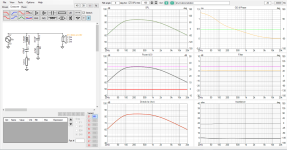
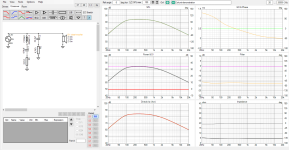
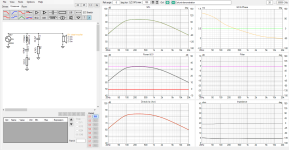
Inspecting what the load is for driver by replacing the amplifier with equivalent resistor, to estimate how much current backEMF can make, thus distortion:
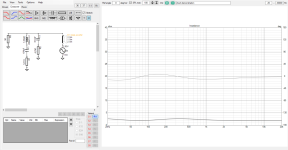
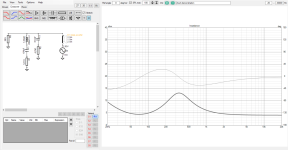
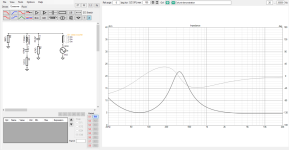
We see the driver load is less than the Ro on all these cases, because the shunts are in parallel with it. In this example, 30ohm Ro without any shunts would provide more distortion reduction, "more current drive", than 300ohm Ro with shunts.

Shunts can be left out only if the speaker was designed for high circuit impedance and to have flattish response without them. Or, use active EQ before amplifier.
On multiway speaker one must accompany such high output impedance amplifier speaker system with DSP or suitable drivers, because if one has to use passive network to straighten frequency response it will shunt the Ro and reduce benefit of current drive. It doesn't matter if its 50 or 500ohms output impedance, if there is few ohm zobel and conjugation networks in parallel. One could use regular (voltage) amplifier and try to increase series impedance when possible, to get almost the same result without trouble, and burning power.
Example:
Shunts enable to maintain acoustic frequency response no matter the amplifier output impedance. Here with 3, 30 and 300ohm Ro.



Inspecting what the load is for driver by replacing the amplifier with equivalent resistor, to estimate how much current backEMF can make, thus distortion:



We see the driver load is less than the Ro on all these cases, because the shunts are in parallel with it. In this example, 30ohm Ro without any shunts would provide more distortion reduction, "more current drive", than 300ohm Ro with shunts.

Shunts can be left out only if the speaker was designed for high circuit impedance and to have flattish response without them. Or, use active EQ before amplifier.
Last edited:
Actually for a speaker, it is if its "Output/Input function does not depend on the absolute time." You can use Prof. Angelo Farina's sweep to check Output/Input quickly and easily in many conditions including at different times while music is being played ... or even during the sweep itself 🙂Why speakers are not time invariant if :
“A system is time-invariant if its output signal does not depend on the absolute time” ?
People would fry their speakers by using 'generic' amplifiers that latch up when the voice coil starts to get hot. So that's just one technical argument why a market for them would be limited to active speakers where the amplifier is thermally matched, EQ'd, and hard-welded to a specific speaker.Hmm.mm! So after 44 pages of ponitificating, there is still no true current drive amp for speakers. Loadsa designs which are wonky current drive .. and only over a limited frequency range .. including all of Merilainen's stuff.. Seems all present designs are really botch jobs. Maybe that's why 'current drive' isn't more popular. When we have 'good' current drive amps, there might be an effort to design speakers to take full advantage of this.
In my book, an amp which did that, is certainly a bodge job and a very poor one at that. As are speakers that need zillions of carefully matched Zobels and/or DSP to sound good.People would fry their speakers by using 'generic' amplifiers that latch up when the voice coil starts to get hot.
- Home
- Amplifiers
- Solid State
- Current drive for Loudspeakers
